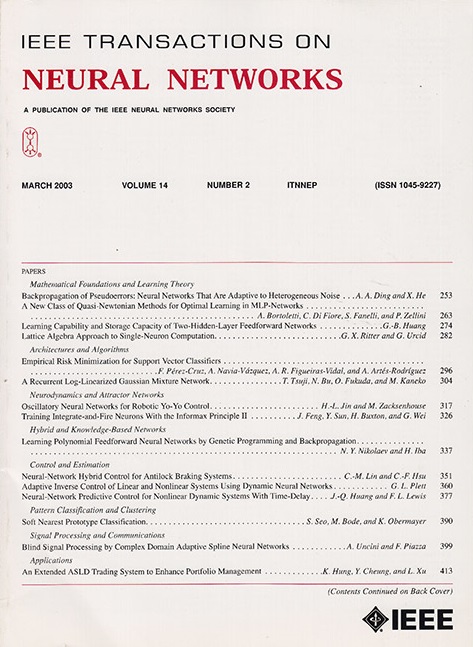基于动态融合和层次增强的少镜头高光谱图像分类。
IF 8.9
1区 计算机科学
Q1 COMPUTER SCIENCE, ARTIFICIAL INTELLIGENCE
IEEE transactions on neural networks and learning systems
Pub Date : 2025-10-07
DOI:10.1109/tnnls.2025.3615950
引用次数: 0
摘要
由于有可能减少对劳动密集型和昂贵的标记数据的依赖,Few-shot学习在高光谱图像分类(HSIC)中引起了越来越多的关注。然而,现有的方法大多局限于使用固定大小的单个图像块进行特征提取,往往忽略了中心像素在特征融合中的关键作用,导致信息利用效率低下。此外,样本特征之间的相关性没有得到充分的挖掘,从而削弱了特征的表达能力,阻碍了跨领域知识的转移。为了解决这些问题,我们提出了一种结合动态融合和分层增强的新型少镜头HSIC框架。具体而言,我们首先引入了一个鲁棒特征提取模块,该模块有效地将小块的内容集中度与大块的噪声鲁棒性结合起来,并通过中心像素引导的动态池化策略进一步捕获局部空间相关性。这种斑块到像素的动态融合使得地物信息的提取更加全面和稳健。然后,我们开发了一个支持查询分层增强模块,该模块集成了类内自关注机制和类间交叉关注机制。这个过程不仅增强了支持级和查询级的特征表示,而且有助于从大量标记的源域学习更多信息丰富的先验知识。此外,为了进一步提高特征的可判别性,我们设计了一个类内一致性损失和一个类间正交性损失,它们共同鼓励类内样本在度量空间中更靠近,类间样本更可分离。在四个基准数据集上的实验结果表明,我们的方法大大提高了分类精度,并且始终优于竞争方法。代码可从https://github.com/guoying918/DFHE2025获得。本文章由计算机程序翻译,如有差异,请以英文原文为准。
Boosting Few-Shot Hyperspectral Image Classification Through Dynamic Fusion and Hierarchical Enhancement.
Few-shot learning has garnered increasing attention in hyperspectral image classification (HSIC) due to its potential to reduce dependency on labor-intensive and costly labeled data. However, most existing methods are constrained to feature extraction using a single image patch of fixed size, and typically neglect the pivotal role of the central pixel in feature fusion, leading to inefficient information utilization. In addition, the correlations among sample features have not been fully explored, thereby weakening feature expressiveness and hindering cross-domain knowledge transfer. To address these issues, we propose a novel few-shot HSIC framework incorporating dynamic fusion and hierarchical enhancement. Specifically, we first introduce a robust feature extraction module, which effectively combines the content concentration of small patches with the noise robustness of large patches, and further captures local spatial correlations through a central-pixel-guided dynamic pooling strategy. Such patch-to-pixel dynamic fusion enables a more comprehensive and robust extraction of ground object information. Then, we develop a support-query hierarchical enhancement module that integrates intraclass self-attention and interclass cross-attention mechanisms. This process not only enhances support-level and query-level feature representation but also facilitates the learning of more informative prior knowledge from the abundantly labeled source domain. Moreover, to further increase feature discriminability, we design an intraclass consistency loss and an interclass orthogonality loss, which collaboratively encourage intraclass samples to be closer together and interclass samples to be more separable in the metric space. Experimental results on four benchmark datasets demonstrate that our method substantially improves classification accuracy and consistently outperforms competing approaches. Code is available at https://github.com/guoying918/DFHE2025.
求助全文
通过发布文献求助,成功后即可免费获取论文全文。
去求助
来源期刊

IEEE transactions on neural networks and learning systems
COMPUTER SCIENCE, ARTIFICIAL INTELLIGENCE-COMPUTER SCIENCE, HARDWARE & ARCHITECTURE
CiteScore
23.80
自引率
9.60%
发文量
2102
审稿时长
3-8 weeks
期刊介绍:
The focus of IEEE Transactions on Neural Networks and Learning Systems is to present scholarly articles discussing the theory, design, and applications of neural networks as well as other learning systems. The journal primarily highlights technical and scientific research in this domain.
 求助内容:
求助内容: 应助结果提醒方式:
应助结果提醒方式:


